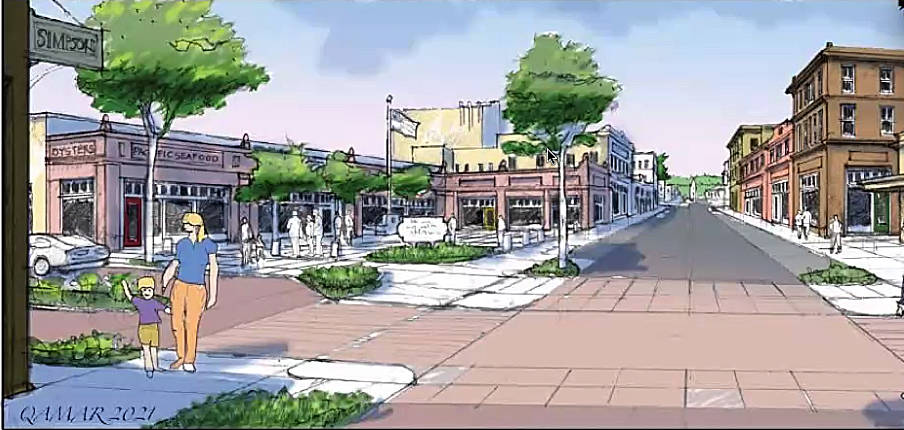An ambitious, long-term plan to revitalize downtown Hoquiam and its historic Olympic Stadium was unveiled on Monday evening.
The plan was presented to the Hoquiam City Council by Qamar and Associates, the firm hired by the city to come up with the blueprint for the future. Hoquiam hired the firm with money from a Washington Department of Commerce grant in September 2020.
“There’s a lot of opportunity here as we see it,” said Michael Mehaffy, an urban designer who is part of the team headed by Laurence Qamar of Qamar and Associates, at the council meeting. “I was incredibly impressed actually with the assets that the city has.”
The recommendations include reconfiguring traffic in and out of town and development of the downtown core to include development of mixed use buildings and spaces along Seventh and Eighth streets, the historic downtown core.
The team behind the plan is the same that developed the town of Seabrook. Seabrook founder Casey Roloff attended the roughly 90-minute presentation.
Roloff said while the Hoquiam plans were ambitious, “A lot of people looked at the ideas for Seabrook 20 years ago as this is pie-in-the-sky and will never work, but their plans helped shape our future for Seabrook.”
Short-term ideas in the plan included painting, signage, the use of trellises and public art to slow traffic through downtown and get travelers to stop, like inserting small parks and gathering spaces in the core, and eventually adding food carts and pop-up shops to make use of some of the gaps in the downtown.
Medium-term suggestions included incorporating liner buildings — thin buildings, as narrow as 15-16 feet wide that line the edge of the street that can house retail spaces and, if desired, housing units above — and incorporating the flood control wall that’s being designed into the landscape.
In the long term, the plan calls for the decoupling of Riverside Avenue and Simpson Avenue, returning them to their historic two-way traffic.
“That would turn the two bridges back into two-way streets, and that slows traffic and brings customers in both directions” through town, said Qamar.
That would include a roundabout at the west end of the Riverside Bridge.
“Currently folks are coming in on Riverside and taking a right just as they hit the downtown edge and head up 101 or 109, virtually bypassing the downtown core,” said Qamar.
Coming back they do drive down Simpson through the downtown core, but with the 30 mph speed limit and truck traffic most blow right by the core businesses.
The plan has a vision for the area of the bus station on Eighth Street that includes moving one of the bus lanes a bit east and adding in a liner building of retail space to face onto the blank wall of the adjacent hardware store.
“There’s a nice park there currently, but as a result of having that blank wall (of the hardware store) it’s not being used quite the way we would have imagined,” said Qamar.
The plan also states that, across the street from the nearby 7th Street Theatre, the existing bank parking lot could be converted into a plaza.
“There’s a great opportunity for a mixed-use building there, with retail and shops spilling into the plaza and residences and offices up above,” said Qamar.
There are also ideas for development of waterfront areas, including along the Hoquiam River at Levee Street and the industrial edge of Grays Harbor. This could include development of a mixed use neighborhood where people are living and shopping, while still incorporating workshop type of businesses.
The plan also includes ideas for Olympic Stadium, starting with better signage to point it out and including, in the future, turning the existing stadium parking lot into a mixed use building, residential spaces with possibly some retail spaces on the ground level.
It’s a far-reaching vision — we’ve hit only a few of the high points from Monday’s presentation here — and will require a lot of public-private partnerships, said Mehaffy. It’s also a long-term plan.
“This is a strategic vision of what it will look like when we get things all filled in,” said Mehaffy of the plan presented to the council. “You’re not going to see this in three (to) five years.”
The plan includes incorporating existing historic buildings, filling in the gaps in between.
Mehaffy called Hoquiam “a diamond in the rough” and said, “In fact, you could become a victim of your own success.”
He urged the city to not assume the plan would drag on, but that it could take off quickly, as other cities have.
“How are you going to grow, and how are you going to preserve the quality of life you have and grow in a way you want to grow?” he said.
He also said it’s important for the city, when implementing short-term plans, to make sure they fit in with the overall plan.
The next step is for the city to approve the plan and begin with the recommended steps. The council made some movement in that direction at the end of Monday’s meeting, calling for the city to look into dropping the speed limit on Simpson Avenue to as low as 20 mph.



